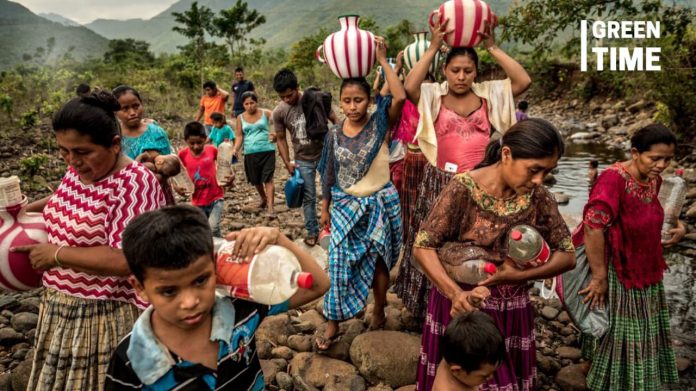Climate change involves long-term variations in temperatures and weather patterns (United Nations). It has been speeding up historic forces of devastation, causing new patterns of human displacements, aggravating existing vulnerabilities, and pushing an expansion of rapid and chaotic
urbanization (IPCC 2014). The International Organization for Migration (IOM) defines climate migration as “the movement of a person or groups of persons who, predominantly for reasons of sudden or progressive change in the environment due to climate change, are obliged to leave their
habitual place of residence, or choose to do so, either temporarily or permanently, within a State or across an international border.” This is a comprehensive word that covers almost all sorts of migration so long as it is mostly in reaction to climate change. Climate change is anticipated to be
a possible cause of human displacement shortly. Migration flows and vulnerabilities are expanding in rural and urban locations where persons are prone to extreme weather conditions, particularly in low-income developing nations (Rahaman et al., 2018)—according to the Global Report on Internal Displacement 2019, war and Catastrophes throughout 148 countries and territories caused 28 million additional displacements in 2018. Catastrophic events contributed nearly two-thirds (61%) of the total new internal displacement in 2018. Moreover, about 250 million people are
predicted to be displaced owing to climate change by 2050 (Centre, 2020). Furthermore, recent research demonstrates that climate variations are typically related to migration (Abel, 2019).
The natural catastrophes in Bangladesh create hundreds of thousands of climate migrants every year (Priovashini & Mallick, 2022). The bulk of them are generated by sudden-onset natural calamities such as cyclones, floods, river erosion, and landslides. Slow-onset tragedies like sea level rise and salinization result in fresh displacements. Several estimations suggest that more than 35 million people in the coastal areas of Bangladesh will be at threat of human migration by 2050 (IDMC 2021). A total of 19 coastal districts with many along the main river banks (Padma, Meghna, and Jamuna) are among the greatest degrees of risk for catastrophes. The natural calamities prompted more than 4 million new climate migrants in 2019, especially for the occurrences of severe cyclones Fani and Bulbul. The yearly fresh displacement rate is 915,083. Particularly, IMDC (IDMC 2021) estimates that the average new migration may reach a higher of
1214,715 in a few years. Still, Bangladesh had the largest number of displacements in the years of 2009, 2013, and 2019. UNFPA Urbanization and Migration in Bangladesh (2016) report shows, that Dhaka and Chattagram districts were the leading areas, where about two-thirds of migrants commute. Dhaka alone takes 42% of the total lifetime among migrants. The overall district-wise distribution of in-migrants also implies that the eastern area of Bangladesh draws more migrants than the western section. The surrounding districts of Dhaka (Munshigang, Gazipur, and
Narayanganj) also fall into this group, where immigration is very high. On the contrary, there are some districts (Rangpur, Faridpur, Sherpur, Mymensingh, Chandpur, Barisal, Bhola, and Patuakhali) with much bigger rates of out-migration than in-migration (UNFPA Urbanization and
migration in Bangladesh 2016). IDMC (2021) claims the effects of disaster-induced human migration disrupt people’s regular livelihoods, heighten food shortages, delay children’s schooling, and elevate the threat of health issues, such as water-borne and infectious infections. The next part
further discusses the social, economic, political, and environmental repercussions of migration, especially focusing on what is occurring in the cities of Bangladesh. Bangladesh was in sixth place in the world according to the number of slum residents, at 30.4 million (Davis, 2006). The research entitled ‘Census of Slum Areas and Floating Population 2014′ done by the Bangladesh Bureau of Statistics (BBS) indicated that there were 13,938 slums in Bangladesh. The census on ‘Slum Areas and Floating Population 2014′ also reveals that there are 13,934 urban slums in Bangladesh and 24.39% of them are located in Dhaka city. The slums of the city occupy barely 5.1% of the city’s overall land, but the population count is very significant. Bangladesh today has around 2.23 million
inhabitants who reside in slum zones in metropolitan regions. According to the Census of Slum Areas and Floating Population 2014, there were around 135,340 slum families (22.75%) in Dhaka North City, 127,585 slum households (21.75%) in Chittagong City, 56,770 slum homes (9.54%)
in Gazipur City, 40,591 slum households (6.82%) in Dhaka South City, 20,658 slum households (3.47%) in Khulna City, 11,927 slum households (2.01%) in Sylhet City, 10,987 slum households (2.01%) in Narayanganj City, 10,202 slum households (1.72%) in Rajshahi City, and 9,629 slum
households (1.61%) in Barishal City, respectively (BBS (Bangladesh Bureau of Statistics) 2015). The World Bank (2007) found that 70% of families in the slums of Dhaka stay under the poverty line (income less than $US 2.50 per day) and do not have access to piped water. The bulk of these
communities are created on vacant, low-lying government or private property. As a result, these settlements are severely prone to floods and waterlogging caused by weak drainage systems and several other natural catastrophes. Furthermore, most of the individuals in such areas are involved in informal sectors like low-paid day labor, rickshaw pulling, and cleaning for their livelihoods since they cannot undertake the activities linked with the official job market. Thus, they do not produce enough money to pay for their housing rent and calorie consumption. Previous research on climate migrants in Bangladesh indicated that the majority of slum inhabitants were jobless or involved in informal employment such as day labor, hawking, vegetable vendors, and so on, with most earning less than BDT10,000 per month (Rahaman et al., 2018).
Bangladesh’s development plans, including the Five-Year Plans, Vision 2041, and the Bangladesh Delta Plan 2100, have been criticized for having a concentrated on thematic and hotspot-specific strategies, often overlooking regional disparities and the challenges of climate migration (Nahar et al., 2019). So, to reduce the ramifications of climate-induced migration, numerous key policy implications and research techniques are advocated. First, improving data and expertise via geographical and temporal databases on migration is crucial for building successful urban plans. Second, there is a need to reframe relocation efforts by shifting climate migrants to secondary cities and less saturated regions to better balance migration-induced risks. Third, creating low income housing programs utilizing the ‘entitlement model’ is necessary to provide suitable social and environmental services for climate migrants. Fourth, a revolutionary approach to land management is necessary to address informal land occupancy and secure legal rights for climate migrants. Finally, sustainable governance involves an integrated approach that blends rural resilience with urban adaptation, and the following research should evaluate how resilient rural communities could reduce migrant flows to cities (Vinke, 2019). In conclusion, managing climate induced migration involves a comprehensive and integrated approach that combines data
collection, policy change, and governance changes. Future research should concentrate on understanding the interaction between rural and urban adaptation methods to better tackle the issues of climate migration.
Reference
Abel, G. J. (2019). Climate, conflict and forced migration. Bangladesh Bureau of Statistics. (2015). Census of slum areas and floating population 2014. Bangladesh Bureau of Statistics. http://www.bbs.gov.bd/ International Organization for Migration. (n.d.). Home. International Organization for Migration. https://www.iom.int/ Intergovernmental Panel on Climate Change. (2014). Climate change 2014: Synthesis report. https://www.ipcc.ch/report/ar5/syr/ Internal Displacement Monitoring Centre. (2021). Global report on internal displacement 2021. https://www.internal-displacement.org/publications/global-report-on-internal-displacement-2021 Nahar, A., Kashem, S., & Das, A. (2019). Regionalization of Bangladesh: A Key to Identify Regional Disparities of the Pattern of Population Distribution. Landscape Architecture and Regional Planning, 4(1), 5. https://doi.org/10.11648/j.larp.20190401.12 Priovashini, C., & Mallick, B. (2022). A bibliometric review on the drivers of environmental migration. Ambio, 51(1), 241–252. https://doi.org/10.1007/s13280-021-01543-9 Rahaman, M. A., Rahman, M. M., Bahauddin, K. Md., Khan, S., & Hassan, S. (2018). Health Disorder of Climate Migrants in Khulna City: An Urban Slum Perspective. International Migration, 56(5), 42–55. https://doi.org/10.1111/imig.12460 United Nations. (n.d.). What is climate change? United Nations. https://www.un.org/en/climatechange/what-is-climate-change United Nations Population Fund. (2016). Urbanization and migration in Bangladesh. United Nations Population Fund. https://www.unfpa.org/resources/urbanization-and-migration bangladesh Vinke, K. (2019). Unsettling settlements: Cities, migrants, climate change: Rural-urban migration in Bangladesh. Palgrave Macmillan. https://books.google.com.bd/books?hl=en&lr=&id=xY2sDwAAQBAJ&oi=fnd&pg=PP1&ots=b 1eN3mggUW&sig=-uHcaaUSP1sRG2AmmUz_ghSbZxY&redir_esc=y#v=onepage&q&f=false
Author: Mst. Najifa Khatun, 3rd Year Student, Environmental Science & Disaster Management, Daffodil International University

